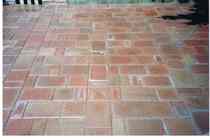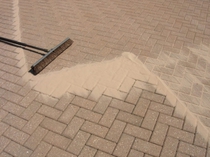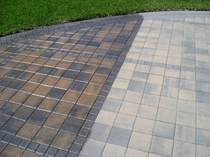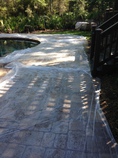
What To Expect
CLEANING
We start the paver sealing process by applying chemicals to kill any mold and algae. Any stains that need treatment will be addressed at this stage as well. Using a high GPM (gallons per minute) hot water pressure washer, we clean the pavers with just the right pressure to not damage the brick paver but get them clean and ready to be sealed. During this step we intentionally "empty" the joints of all previous sand and the dirt.
Efflorescence and Stain Treatment
Efflorescence is a crystaline deposit on surfaces of masonry, stucco or concrete. It is whitish in appearance, and is sometimes a serious issue. Efflorescence has been a problem for many years, and is a topic of much controversy. The formation of these salt deposits are not mysteries. They are, for the most part, water-soluble salts that come from many possible sources to mar and detract from an otherwise beautiful and serviceable structure
Using a mild organic acid called an Efflorescence Cleaner removes any surface residue as well as penetrates into the paver to dissolve any other salts that will produce the white haze in the future. This is a crucial step in the process as it is your only chance to treat it before sealing. Once it is sealed it will be locked under the sealer if it surfaces. We include this treatment into the cost of our sealing process.
SANDING
Once the pavers are clean and the joints have been emptied we proceed with sanding. During this step we work a coarse sand into the joints. Our unique "wet sanding" method includes a specialized technique where we use low pressure water spray to work the sand into the joints for optimized density and stabilization. This is time consuming, however, a vital step in completing the process as required by the manufacturer. Over sanding, under sanding, dry sanding and using the wrong sand are prevalent in almost all paver sealing jobs we see by other companies.
Fact: A properly sanded joint should be 1/16" to 1/8" below the edge of the joint. (you shouldn't see sand everywhere!)
SEALING
So now the pavers are cleaned and sanded we go over the surface with a leaf blower to remove any loose sand particles to provide a smooth surface. Once that is completed we proceed with applying the sealer. The state of the art sealer we use is breathable. This means even a little moisture remaining in the joints or surface will be allowed to escape and not "blush" (turn white). This allows us to apply a flood coat of paver sealer that penetrates deep into the joints and hardens the joint sand, locking in the pavers and keeping the weeds and insects out. We follow the flood coat with a higher concentrated mixture of paver sealer that provides the surface protection and enhancement that will leave the pavers looking wet, not glossy (if you choose our Super Wet product) or with a Natural looking finish (Natural Luster). We use a low psi electric sprayer for application. The use of a high psi paint sprayer is common practice by most all other companies and is the reason superior joint stabilization isn't achieved. On average we use more sealer per square foot than any other paver sealing company!
STRIPPING
This step is actually performed first if you are a candidate. However, most pavers don't require this step. If you are unfortunate enough to have paid good money to see your pavers turn white or blotchy, then Paver Saver sends its condolences. Poor applications and cheap products have a way of showing their true colors in time....WHITE! When this happens the brick pavers turn either very foggy looking or completely white. The application of a very high end stripping agent must be applied and then the old sealer removed before you can apply ANY new sealer. Paver Saver only uses environmentally friendly products, including a BIO STRIPPER. It safe to work with and has a long workable time frame which allows us to ensure a quality strip. Our process of stripping the old sealer requires us to apply the stripper then cover it with plastic. Depending on the time of year we may let it sit for a few hours or overnight. Then we must painstakingly pressure clean all the old dissolved sealer off. A job for professionals!






